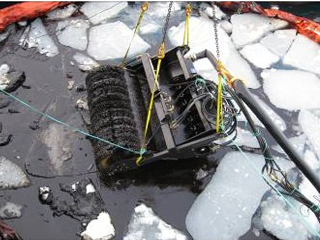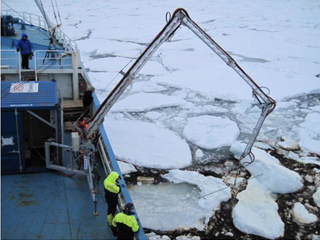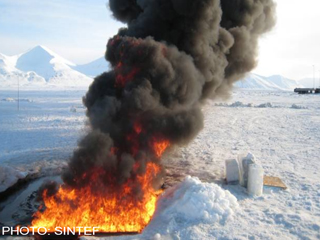At-Sea Response to Arctic Oil Spills

The main at-sea response options for the Arctic are containment and recovery, chemical dispersion, and in-situ burning.
Containment & Recovery of Oil in Ice
Mechanical recovery of oil in ice is physically challenging. The presence of ice is likely to prevent the use of booms. The extreme cold meanwhile may hinder the operation of skimmers and pumps, and will increase the viscosity of spilled oil. However, the containment of oil in ice and the limited weathering (especially emulsification) may aid recovery. Specialised skimmers and ‘winterised’ pumps and power packs have been developed for Arctic conditions.
Whilst mechanical recovery is a pre-approved technique in Arctic territorial waters, it is unlikely to be an efficient response option above ~30% ice cover. The availability of suitable vessels and facilities for the storage and disposal of recovered oil will also be major considerations.
Dispersant trials

Dispersants are widely used to respond to oil spills at lower latitudes, and have the advantage of treating oil in situ rather than recovering it for subsequent disposal. Specific formulations are being developed for the Arctic, where the limited oil weathering and emulsification may extend the window of opportunity for application to days or even weeks. However, dispersion can only occur if dispersants come into contact with oil, making the treatment of oil trapped among ice floes difficult. The dampening effect of sea ice means that artificial mixing of the water column (e.g. using propeller wash) may be necessary.
Dispersant use is not a pre-approved technique among Arctic States, and is unlikely to be permitted in shallow, nearshore waters or in the vicinity of sensitive benthic resources or fish spawning grounds.
In-situ burning test

In-situ burning of oil is capable of removing large volumes of oil from the water surface with minimal waste generation. In the Arctic the minimum slick thickness required to sustain an efficient burn may be achieved by containment in ice. In Arctic conditions ignition or combustion aids may be required to start and sustain a burn.
Whilst experimental burns have reported oil removal efficiencies in excess of 90%, resultant tar-like residues with a tendency to sink may be produced. The toxicity and physical smothering impacts of such residues on Arctic flora and fauna have not yet been tested. In-situ burning is not a pre-approved technique for the Arctic, and it is likely that the dense smoke plume generated would restrict burns in close proximity to sensitive coastal resources.
